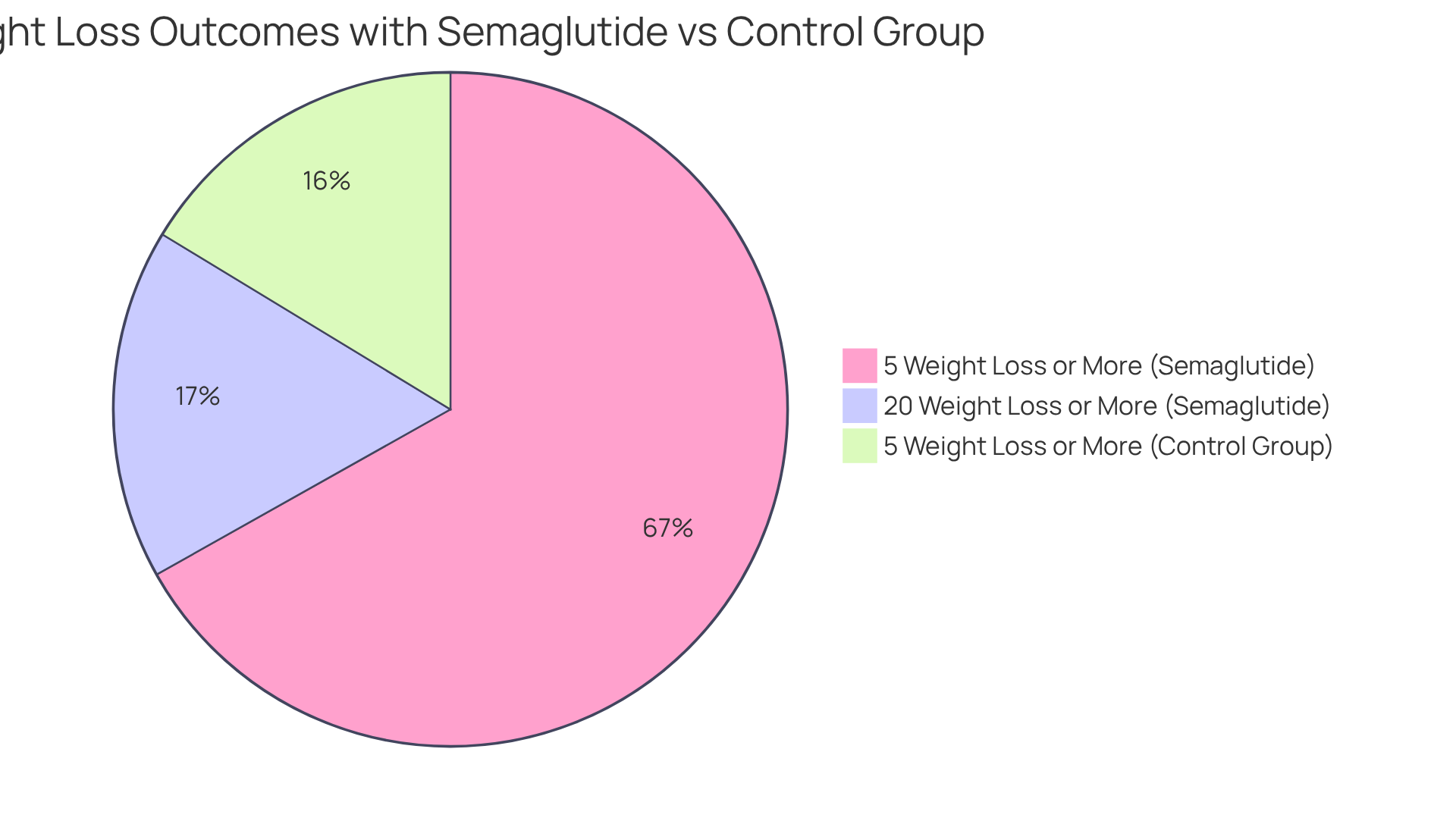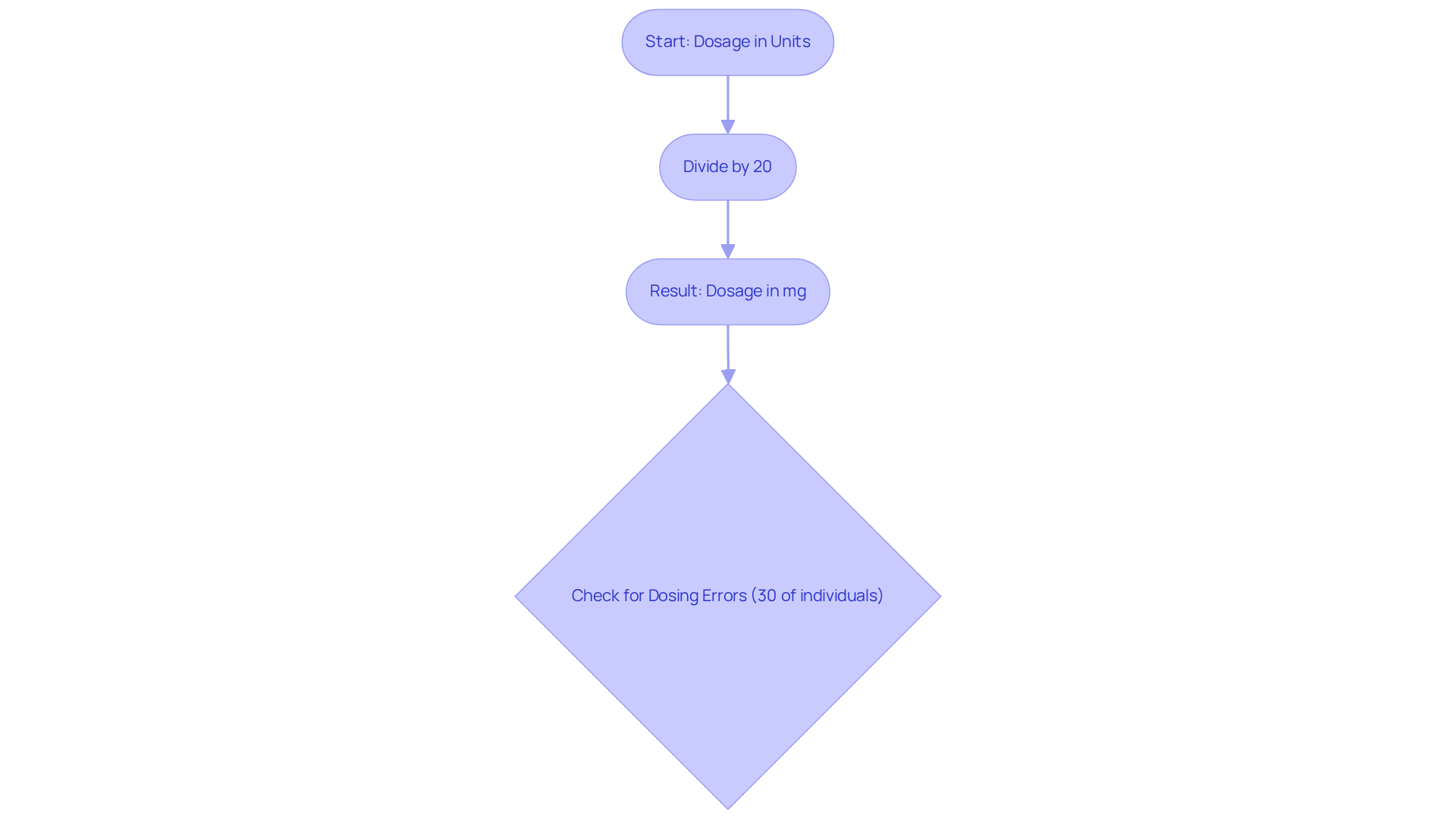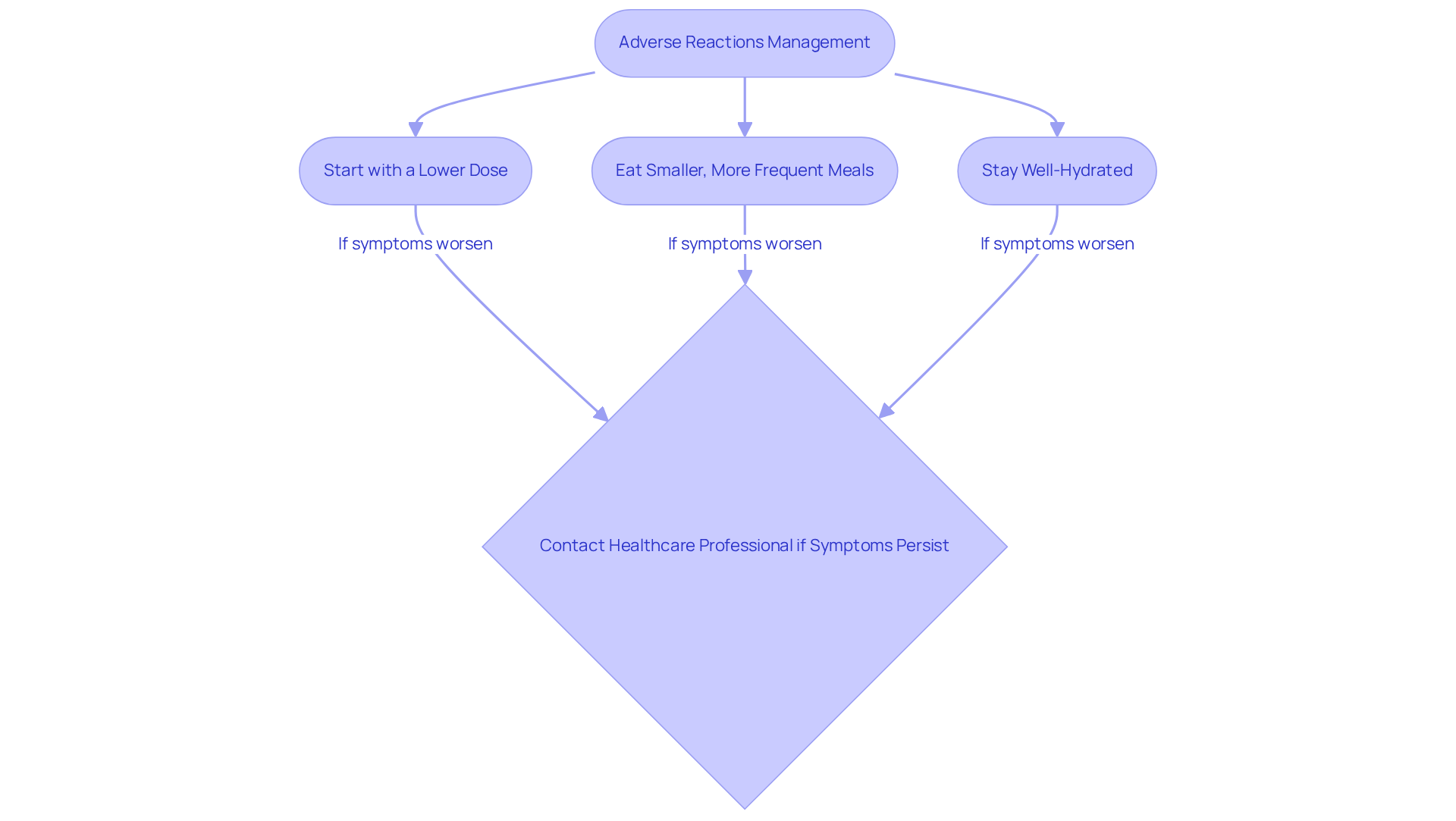Overview
Understanding the importance of accurate dosing is crucial in your weight loss journey. Did you know that 15 units of Semaglutide is equivalent to just 0.75 mg? This conversion is achieved by dividing the number of units by 20. It’s essential to get this right, as improper dosing can lead to inadequate results or increased side effects.
We know that navigating treatment can feel overwhelming at times. That’s why we’re here for you, to ensure that you have the information you need for effective treatment outcomes. Remember, together, we can achieve your goals, and every step you take is a step towards a healthier you.
Take heart in knowing that with the right support and guidance, you can overcome these challenges. Your health is our priority, and we are committed to walking alongside you in this journey.
Introduction
Navigating the complexities of medication dosing can often feel overwhelming, particularly when it comes to treatments like Semaglutide. This remarkable glucagon-like peptide-1 (GLP-1) receptor agonist not only supports the management of type 2 diabetes but also plays a vital role in weight loss for those facing obesity challenges.
As the dialogue surrounding effective dosing evolves, a crucial question emerges: how can you accurately convert the prescribed units of Semaglutide into milligrams? This article explores the essential conversion process, its implications for treatment effectiveness, and the significance of precise dosing in achieving optimal health outcomes.
Together, we can work towards understanding these important aspects to empower your health journey.
Overview of Semaglutide: Mechanism and Uses
Semaglutide is a glucagon-like peptide-1 (GLP-1) receptor agonist that mimics the effects of the natural hormone GLP-1 in the body. This medication works by enhancing insulin secretion in response to meals, reducing glucagon release, and slowing gastric emptying. These actions help to lower blood sugar levels and promote a feeling of fullness, which can be incredibly beneficial for those navigating their weight loss journey.
Primarily utilized for managing type 2 diabetes and aiding weight loss in individuals with obesity, Semaglutide has shown promising results. Clinical studies reveal that many individuals can achieve significant weight loss when this medication is paired with a reduced-calorie diet and increased physical activity. For instance, a cohort study found that:
- 87.3% of participants experienced at least a 5% reduction in body weight after 6 months.
- 22% shed 20% or more after 12 months.
Isn’t that inspiring?
Additionally, 67.8% of those receiving Semaglutide experienced a weight reduction of 5% or more at week 104, compared to just 21.3% in the control group. Administered through a convenient weekly subcutaneous injection, this medication offers a supportive option for many individuals, making it a favored choice in obesity management and chronic control.
Dr. Chance Miller emphasizes the importance of this treatment, stating, “We intend to evaluate weight loss results linked to the treatment for individuals with excess weight or obesity and for those with or without type 2 diabetes.” The SELECT trial further demonstrated a remarkable completion rate of 97.1% for the treatment group, highlighting the strength of the study and the reliability of its findings.
Significantly, Semaglutide is also associated with a considerable decrease in major adverse cardiovascular events, enhancing its appeal for individuals concerned about overall health. Remember, together, we can achieve your goals, and with the right support and tools, your journey toward better health is within reach.
Understanding the Conversion: Units to Milligrams
Changing the dosage of your medication from units to milligrams can feel overwhelming, but we’re here to help you through it. To make this conversion, simply divide the number of units by 20. For instance, if you have 15 units of the medication, then the question arises: 15 units of semaglutide is how many mg, which corresponds to 0.75 mg (15 units ÷ 20 = 0.75 mg). Understanding this conversion is crucial, especially since this medication is often prescribed in units, particularly with injection pens.
Accurate dosing is vital for effective treatment outcomes. Did you know that studies show dosing errors can lead to insufficient treatment or increased side effects? In fact, recent statistics reveal that about 30% of individuals encounter dosing errors when using this medication. This highlights the significance of ensuring accuracy in your dosing.
By grasping this conversion, you can feel confident that you’re receiving the correct dosage as prescribed by your healthcare provider. This understanding can enhance your weight loss journey and overall health. As Dr. Anjmun Sharma from Buffalo Weight Loss wisely states, ‘Understanding the appropriate dosage and administration of this medication is crucial for optimal results.’ Together, we can achieve your goals and ensure you stay on the right path.
Dosing Guidelines: Administration and Adjustments
Starting your weight loss journey can feel overwhelming, but we’re here to support you every step of the way. The initial suggested dosage of the drug is 0.25 mg, administered subcutaneously once a week for the first four weeks. This allows your body to adjust to the medication gently. After this introductory phase, you may find that increasing the dosage to 0.5 mg weekly could be beneficial, with further adjustments made based on your individual tolerance and clinical response.
It’s important to note that the maximum prescribed dose can reach up to 2.4 mg weekly, which raises the question of how many mg are in 15 units of semaglutide, and this has been linked to enhanced weight loss outcomes. Research shows that 67.8% of patients experience at least a 5% decrease in body weight within just a few months of starting treatment. For optimal results, semaglutide should be administered at the same time each week, regardless of meal timing, to ensure stable plasma levels.
We understand that side effects like nausea and diarrhea can be concerning, which is why a gradual titration plan—where the dosage is progressively increased—can help minimize these issues. Regular meetings with your healthcare professionals are crucial for tailoring your dosage to your unique progress and any adverse reactions you may encounter. This customized approach is essential for enhancing the effectiveness of the medication in your weight management journey.
Together, we can achieve your goals, and many patients find that they shed an average of around 6.7 kg (14.8 pounds) in the first three months. Remember, you are not alone in this journey, and with the right support and guidance, you can reach your desired outcomes.
Managing Side Effects: What to Expect and How to Cope
It’s completely understandable to feel concerned about the typical adverse reactions of the medication, which can include nausea, vomiting, diarrhea, and abdominal pain. Research shows that these symptoms are usually mild and often improve as your body adjusts to the medication. In clinical studies, around 82.8% of semaglutide participants reported gastrointestinal adverse events, with most being mild to moderate and transient in nature.
To help manage these secondary reactions effectively, we recommend:
- Starting with a lower dose and gradually increasing it.
- Eating smaller, more frequent meals.
- Staying well-hydrated.
If these adverse reactions persist or worsen, please don’t hesitate to reach out to a healthcare professional for guidance. Remember, understanding that these side effects are common can help ease your anxiety and encourage you to stick with your treatment plan.
Healthcare professionals want you to know that while gastrointestinal reactions are prevalent, they often diminish over time. This allows you to concentrate on your weight loss goals. Together, we can achieve your goals, and we’re here for you every step of the way.
Conclusion
Understanding the dosing of Semaglutide is crucial for anyone looking to effectively manage their weight and blood sugar levels. This article has provided a comprehensive overview of how to convert the medication from units to milligrams, emphasizing that 15 units of Semaglutide equate to 0.75 mg. By grasping this conversion, you can ensure that you are following your healthcare provider’s prescriptions accurately, which is essential for achieving optimal health outcomes.
Key insights discussed include:
- The medication’s mechanism of action
- Its efficacy in promoting weight loss
- The importance of starting with a lower dose to minimize side effects
With a significant percentage of users experiencing weight loss and improved health markers, Semaglutide stands out as a valuable tool in managing type 2 diabetes and obesity. It’s also important to regularly consult with healthcare professionals to tailor your treatment plan effectively.
Navigating the complexities of Semaglutide dosing can empower you on your health journey. By understanding the conversion from units to milligrams and recognizing the potential side effects, you can approach your treatment with confidence. Embracing this knowledge not only enhances the likelihood of successful outcomes but also underscores the importance of informed and proactive healthcare engagement. Together, we can achieve your goals and support you every step of the way.
Frequently Asked Questions
What is Semaglutide and how does it work?
Semaglutide is a glucagon-like peptide-1 (GLP-1) receptor agonist that mimics the natural hormone GLP-1 in the body. It enhances insulin secretion in response to meals, reduces glucagon release, and slows gastric emptying, which helps lower blood sugar levels and promotes a feeling of fullness.
What are the primary uses of Semaglutide?
Semaglutide is primarily used for managing type 2 diabetes and aiding weight loss in individuals with obesity.
What results have clinical studies shown regarding weight loss with Semaglutide?
Clinical studies have shown that many individuals can achieve significant weight loss with Semaglutide when combined with a reduced-calorie diet and increased physical activity. For example, 87.3% of participants experienced at least a 5% reduction in body weight after 6 months, and 22% lost 20% or more after 12 months.
How effective is Semaglutide compared to a control group?
In a study, 67.8% of those receiving Semaglutide experienced a weight reduction of 5% or more at week 104, compared to only 21.3% in the control group.
How is Semaglutide administered?
Semaglutide is administered through a convenient weekly subcutaneous injection.
What does Dr. Chance Miller say about Semaglutide’s impact on weight loss?
Dr. Chance Miller emphasizes the importance of evaluating weight loss results linked to Semaglutide treatment for individuals with excess weight or obesity, whether or not they have type 2 diabetes.
What was the completion rate of the SELECT trial for Semaglutide?
The SELECT trial demonstrated a remarkable completion rate of 97.1% for the treatment group, highlighting the reliability of its findings.
Does Semaglutide have any cardiovascular benefits?
Yes, Semaglutide is associated with a considerable decrease in major adverse cardiovascular events, making it appealing for individuals concerned about overall health.





















